49er High Performance Skiff
49ER AT A GLANCE

A TRUE HIGH-PERFORMANCE SKIFF
The 49er one-design skiff has transformed dinghy racing offering performance, excitement and spectacle together with the unmatched ferocity of competition only generated in Olympic fleets.
The hull designed by Julian Bethwaite is lightweight and offers minimal resistance with no noticeable speed hump, unlike other boats at the time. The most noticeable feature of the 49er skiff is the solid wings which make the boat easier to sail and generate massive righting moment. The 49er adopted a new sail plan and full carbon mast in 2008 which has enabled the boat to stay in line with modern developments in rig design.

| Fitted Hull Weight | 94kg |
| Length | 4.99m |
| Width | 2.9m |
| Mast Length | 8.4m |
| Upwind Sail Area | 21.2sqm |
| Spinnaker Area | 38sqm |
| Designer | Julian Bethwaite |
| Year Designed | 1996 |
| Number of Sailors | 2, Twin Trapeze |
| Ideal Racing Weight | 150-170kg |
Association Link 49er.org
49er Complete Ready to Sail
- 49er Hull package (G40021)
- Complete CST mast (Inc wires, halyards & trapeze system)
- North Main and Jib
- Pryde Spinnaker
- Launching trolley
Price: £30,250.00
£25,208.33 (ex VAT)
49er Hull package – Ex Spars & Sails
- Fully fitted hull
- Spinnaker pole
- Spinnaker sock
- Boom with vang arms
- Rudder Stock
- Twin Carbon Kevlar Tiller Extensions
- Rig Bag inc Turnbuckles for both lowers and main shrouds and adjusters
- Control line blocks
- Boat Breaker
Price: £20,450
£17,041.67 (ex VAT)
49er Hull inc Wings
- Spinnaker Pole
- Spinnaker Sock
Excluding :
- Rudder stock
Price: £17,995
£14,995.83 (ex VAT)
49er Hull and deck only
Price: £13,500
£11,250.00 (ex VAT)

49er Top cover – Wings stowed

49er Top cover – Wings out – Canvas – Banks

Ovington Rig Bag

49er Under cover
Looking for something else, we sell parts & spares.
From sails to rigging, mast fittings and covers.
TERMS & CONDITIONS
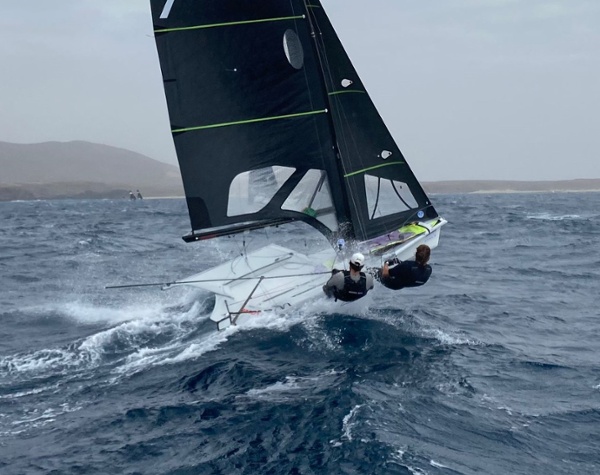
Adrenaline pumping speed. The skiff that flies.
It's one of the most powerful experiences in high performance, double handed skiff sailing. Using a twin trapeze, self-tacking jib, asymmetric gennaker and solid wings, the Mackay built 49er reaches speeds of 25 knots. It's also the boat used by Olympic winning and World Champion teams.
Find out more in the Features section below
Specifications
No of crew: 2
Opt. crew weight: 145 – 165 kg’s
No. Trapeze: Twin
Hull material: GRP
Hull length: 4.995m
Beam length: 2.9m
Hull weight: 94kg
Mainsail area: 16.1m2
Headsail area: 5.1m2
Spinnaker area: 21.2 m2
The 49er is the men's Olympic Skiff Class.
49er Class association website http://49er.org/
The 49er is 16ft long and made of fiberglass and carbon fibre for optimum strength and lightweight. Weighing 125 kgs when fully rigged, its optimal length to weight ratio and very fine hull lines, help produce excellent lift in waves and maneuverability.
The Wings
The boat features distinctive wings 9ft wide to allow the crew to achieve maximum leverage and to support the rig. The wings are designed to blend into the hull and cockpit area which optimises aerodynamics and makes it easy to move around. The wings are fastened to the hull and can be easily detached.
CST became the carbon fibre tube suppliers in 2021. All tubes are QA checked plus bend and weigh tested by CST to ensure consistency.
The mast is assembled by the class builders. All mast fittings are the same on the 49er and FX so spare parts can be used for either boat.
The spreaders are built from recycled carbon. The mast join system and spreader base was recently redesigned for added strength around the trapeze area.
The huge sail area for such a small boat means that the 49er can sail faster than the speed of the wind.
The Class is moving to a new range of sails in 2022. The main and jib sails will be built by North Sails using the 3Di technology which is a 3D full sized molding construction process that uses composite materials. The technology enables sails to be built to the desired shape and retain shape over time. This change to the “black sails” will improve the longevity and consistency while also decreasing the overall cost of sails.
The spinnaker has also undergone design changes and will be built by McDiarmid Sails.
The new sails are currently under development and due to be available in early 2022.
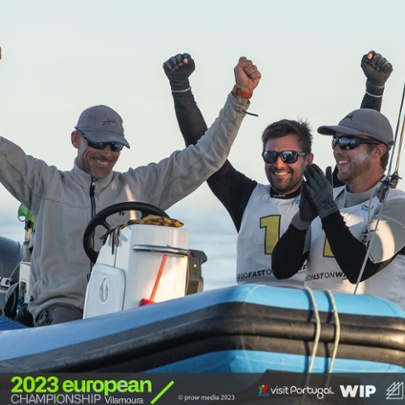
Congratulations to the 2023 49er/49erFX European Championship winners
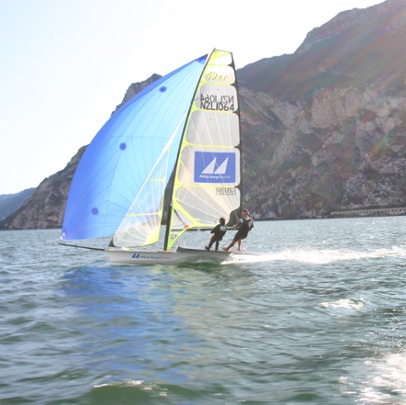
Developing the 49er Class
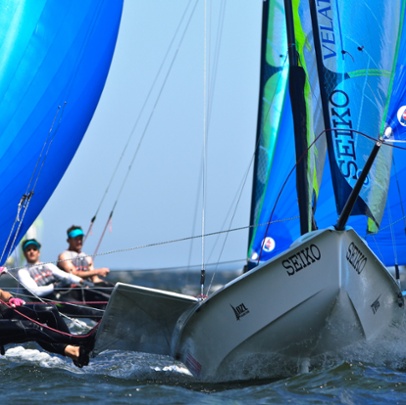
49er Recent Successes
What is included in the full 49er package.
The boat package comes complete with all ropes and sheets from Robline, rudderstock, 2 x tiller extensions, gennaker pole, boom and turnbuckle set.
The Rig package comes complete with mast, wires, halyards, halyard adjusters, trapeze lines and trapeze adjusters.
***Boatbreaker and footstraps are not included and need to be ordered as extra items.
What can be customized on the 49er?
The concept of the 49er is that all boats are the same. We offer the option to upgrade to EVA foam for non-skid on the wings and also offer a service to custom pack and align the centrecase.
Where do I get class numbers and country flag for sails from?
Sail numbers and flag details can be found on the class website: 49er Class Association
Can I retrofit the 49er?
The class rules clearly state what can be added and changed on the boat as part of maintenance. Blocks and ropes can be replaced with similar products by other manufacturers. Please read the rules carefully and remember, you cannot change anything unless the rule specifically allow it.
How should the wings be safely transported?
Wings must be transported with the foam blocks under each wing to stop the underside denting on the wing plinths on the deck. Make sure they are tied down well so they don’t fly away!
Place padding under the ties in the non-skid areas to protect your non-skid and stop it wearing.
How to do a gelcoat repair?
Small gel coat repairs are relatively easy to do.
What is Gelcoat made up of?
Gelcoat is a polyester product that is cured by using a catalyst called MEKP. (Methyl Ethyl Ketone Peroxide)
MEKP is a dangerous substance and should be treated as such when using, being very careful not to get any on your skin or in your eyes.
How can I get the catalyst - MERK?
We cannot ship MEKP so you will always need to buy it separately from your local marine store or fibreglass manufacturer.
How much MERK do I need?
The amount of Catalyst varies depending on the conditions you are using it in, but around 2%-3% will always work.
It is best to use a small syringe or dropper to get the required catalyst rate.
If you have mixed 100gm of gelcoat, then you are aiming for 2ml of catalyst.
Generally, polyester doesn’t stick well to Epoxy, so if you are repairing an epoxy boat, then you should source a special epoxy compatible gelcoat.
What are the Gelcoat colours?
Gelcoats colours are not always a 100% perfect match.
Colour will vary depending on the depth of the repair and the batch.
49er, VX One & Zephyr are built from Epoxy resin.
For the epoxy boats we use a product made by Scot Bader.
Grey is Crystic 253 RAL= 7035
White is Crystic 253 PA - White 337
Does Mackay Boats supply gelcoat?
We supply a small tin (of each relevant colour) with each new boat.
Order additional gelcoat from our store, although it cannot be shipped by courier.
How do I do gelcoat repairs?
Doing gelcoat repairs is an art that improves with experience.
Making sure the surface is prepared well and keyed up is critical.
Overfill and then sanding back is a slow and time-consuming process.
Be very careful not to scratch the boat around the repair.
You shouldn’t sand the original surface around the repair with any paper coarser than 600grit.
Mask around the repair to protect the boat.
You can initially use a file or 150g to take the high parts off the filling, but don't use the coarse paper for too long or you will end up with scratches in the finished repair.
Once you have it fair with 600g, you can work your way through the sandpaper grades until you finish with 1500grit before cutting and polishing.
We would typically use 600g, then 800g or 1000g, then 1200g, then finally 1500g.
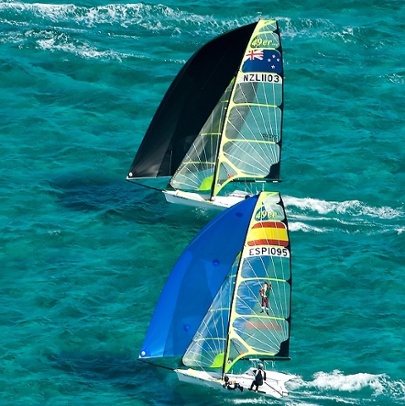
49er Tuning Tips
Are you sure you want to change currency.
International 49er & 49erFX Class Association
Class contact information.
Click below
Class Email
Class Website
One-Design Class Type: Dinghy
Was this boat built to be sailed by youth or adults? Adult
Approximately how many class members do you have? 70
Photo Credit:Ricardo Pinto
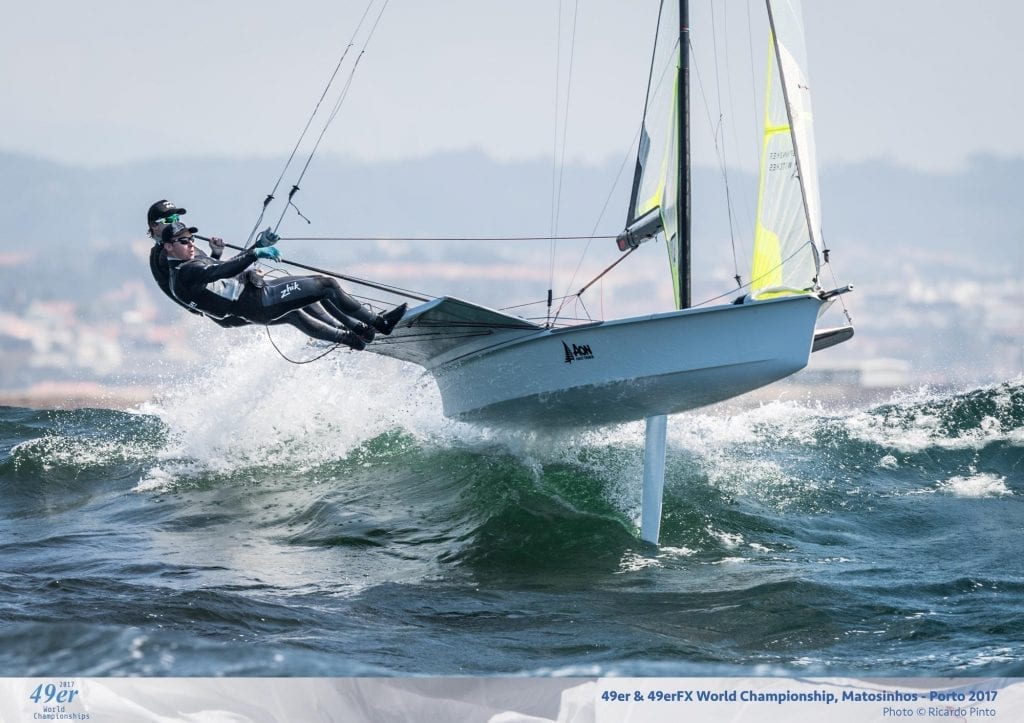
Photo Credit: Ramon Oliden

Photo Credit: Ivan Bulaja
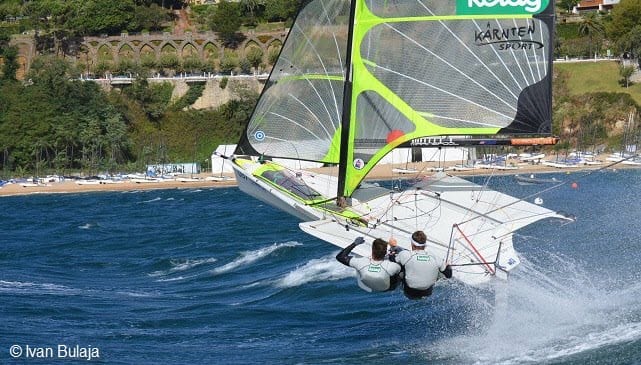
About International 49er & 49erFX Class Association
The 49er and 49erFX are the premiere Olympic skiff. Designed by famous Australian skiff sailor / designed, Julian Bethwaite, the 49er represents the culmination of high performance sailing, remaining the gold standard for athletic competition on water and becoming a proving ground for today’s top International sailors. Using a twin trapeze, self-tacking jib, asymmetric gennaker and solid wings, the 49er and 49erFX can reach speeds of 25 knots. With the addition of the 49erFX variant, the class has opened up to younger, smaller and female sailors while still providing all the same excitement.
Boats Produced: 2200
Class boat builder(s):
Mackay Boats Ltd Ovington Boats Ltd
Approximately how many boats are in the USA/North America? 140
Where is your One-Design class typically sailed in the USA? List regions of the country:
Florida, New York, California
Does this class have a spinnaker or gennaker? Yes
How many people sail as a crew including the helm? 2
Ideal combined weight of range of crew: 350
Portsmouth Yardstick Rating: 740
Boat Designed in 1995
Length (feet/inches): 16’8″
Beam: 9′
Weight of rigged boat without sails: 275
Draft: 3′
Mast Height: 27′
Coaching or Clinic Resources
Tuning guides.
Back to One-Design Central
Copyright ©2018-2024 United States Sailing Association. All rights reserved. US Sailing is a 501(c)3 organization. Website designed & developed by Design Principles, Inc. -->
Great choice! Your favorites are temporarily saved for this session. Sign in to save them permanently, access them on any device, and receive relevant alerts.
- Sailboat Guide

49ER is a 16 ′ 0 ″ / 4.9 m monohull sailboat designed by Bethwaite Design and built by Ovington Boats Ltd., MacKay Boats Ltd., LaserPerformance, and Nautivela starting in 1999.

Rig and Sails
Auxilary power, accomodations, calculations.
The theoretical maximum speed that a displacement hull can move efficiently through the water is determined by it's waterline length and displacement. It may be unable to reach this speed if the boat is underpowered or heavily loaded, though it may exceed this speed given enough power. Read more.
Classic hull speed formula:
Hull Speed = 1.34 x √LWL
Max Speed/Length ratio = 8.26 ÷ Displacement/Length ratio .311 Hull Speed = Max Speed/Length ratio x √LWL
Sail Area / Displacement Ratio
A measure of the power of the sails relative to the weight of the boat. The higher the number, the higher the performance, but the harder the boat will be to handle. This ratio is a "non-dimensional" value that facilitates comparisons between boats of different types and sizes. Read more.
SA/D = SA ÷ (D ÷ 64) 2/3
- SA : Sail area in square feet, derived by adding the mainsail area to 100% of the foretriangle area (the lateral area above the deck between the mast and the forestay).
- D : Displacement in pounds.
Ballast / Displacement Ratio
A measure of the stability of a boat's hull that suggests how well a monohull will stand up to its sails. The ballast displacement ratio indicates how much of the weight of a boat is placed for maximum stability against capsizing and is an indicator of stiffness and resistance to capsize.
Ballast / Displacement * 100

Displacement / Length Ratio
A measure of the weight of the boat relative to it's length at the waterline. The higher a boat’s D/L ratio, the more easily it will carry a load and the more comfortable its motion will be. The lower a boat's ratio is, the less power it takes to drive the boat to its nominal hull speed or beyond. Read more.
D/L = (D ÷ 2240) ÷ (0.01 x LWL)³
- D: Displacement of the boat in pounds.
- LWL: Waterline length in feet
Comfort Ratio
This ratio assess how quickly and abruptly a boat’s hull reacts to waves in a significant seaway, these being the elements of a boat’s motion most likely to cause seasickness. Read more.
Comfort ratio = D ÷ (.65 x (.7 LWL + .3 LOA) x Beam 1.33 )
- D: Displacement of the boat in pounds
- LOA: Length overall in feet
- Beam: Width of boat at the widest point in feet
Capsize Screening Formula
This formula attempts to indicate whether a given boat might be too wide and light to readily right itself after being overturned in extreme conditions. Read more.
CSV = Beam ÷ ³√(D / 64)
Beam with wings removed: 5.58’. Olympic class since 2002.
Embed this page on your own website by copying and pasting this code.
- About Sailboat Guide
©2024 Sea Time Tech, LLC
This site is protected by reCAPTCHA and the Google Privacy Policy and Terms of Service apply.
- {{>productsMenu}} Products
- {{>trendsMenu}} News & Trends
- Catalogs >
- Ovington >
- News & Trends
- Exhibitions
49er 2 Pages

Catalog excerpts

The 49er is the two person one-design skiff which has transformed competitive dinghy sailing offering performance, excitement and spectacle, previously only found in 18 footers, together with the unmatched ferocity of competition only generated in Olympic fleets. Designed by skiff supremo Julian Bethwaite, the ultra light, slender hull offers minimal resistance with no noticeable speed hump. This means the 49er smoothly accelerates onto the plane and the speed just goes on rising. The most remarkable feature of the 49er at first sight is its solid wings which make the boat safe and a joy to sail. Running from wing to wing is easy helping newcomers quickly climb the "skiff learning curve". Trapezing from these wide wings, the crew members generate a massive righting moment to control the power from the huge sail area, and continue accelerating the boat. The enormous sail area means that the 49er is fully powered up in about 8 knots of breeze. The composite mast gives effective gust response above this wind speed, making control of such a large rig possible. The high boom means there is plenty of room to move around the boat, whilst a self tacking jib frees the crew is to concentrate on playing the mainsail upwind and the asymmetric spinnaker downwind. The short foot on the spinnaker and radical new style of cut means the sheet loads are kept to a minimum, allowing many shapes and sizes of crews to sail the boat effectively. For more information: Contact Dave Hall on 07719 59 49 49 or [email protected]

Overall Length Hull Weight Main & Foresail Asymmetric Spinnaker Julian Bethwaite Epoxy GRP with foam sandwich laminate for stiffness and light weight. Carbon fibre in high load areas. GRP laminate with foam core, making exceptionally light and strong dagger board and rudder blade. GRP rudder stock with vertically lifting "dagger" style rudder blade. From 2009 an all carbon mast will replace the alloy/ carbon- glass spar. Aluminium alloy boom. Composite Fully battened mainsail and jib for shape stability and long competitive life. Mylar film with Kevlar and aramid fibre weave for light...
All Ovington catalogs and brochures

4 Pages

1 Pages

Archived catalogs

Related Searches
- Marine sailboat
- Sailboat with bowsprit
- Nautical sailing dinghy
- Transportable open sailboat
- Regatta sailing dinghy
- Single-handed sailing dinghy
- Multiple sailing dinghy
- Carbon mast sailboat
- Double-handed sailing dinghy
- Carbon sailboat
- Sport keelboat sailboat
- Catboat sailing dinghy
- Sailing skiff
- Asymmetric spinnaker sailing dinghy
- Single-trapeze sailing dinghy
- Optimist sailing dinghy
- Double-trapeze sailing dinghy
- Carbon sailing dinghy
- 49er sailing dinghy
- Manufacturer account
- Buyer account
- Our services
- Newsletter subscription
- AboutVirtualExpo Group

By Product Categories
Small Boat Blocks
Big Boat Blocks
Complementary Hardware
Travelers & Genoa Leads
Mainsail Handling
Headsail Handling
Mooring Solutions
Spare Parts
Accessories
Harken Canvas
Sportfishing
Fly Soft-Attach Blocks
Carbo Air Blocks
Small Boat Classic
Flip-Flop Small Boat
GP Catamaran Ceramic Mainsheet Systems
Protexit™ Exit Blocks
Through-Deck
Wire High-Strength
Dinghy Vang
Small Boat Deck Organizers
Midrange Classic
Midrange Deck Organizers
Zircon Blocks
Element Blocks
Black Magic Air Blocks
Cruising ESP Blocks
Megayacht Blocks
Stainless Steel Blocks
Black Magic Air Runners
FlatWinder Powered Blocks
Mastbase Blocks
Over-the-Top
Crossover Blocks
Big Boat Deck Organizers
Cam Cleats & Kits
Cam Cleat Accessories
Cam Cleat Bases
Stand-Up Bases
Deck Organizers
Spinnaker Pole Cars
Soft Attachments
Fixed Padeyes
Removable Padeyes
Bolt-Down Fairleads
Grand Prix Jib Leads
Halyard Tensioners
Tiller Extensions
Peter's Desk Drawer
Dinghy Jib Leads
Crossbow Pivoting Self-Tacking Jib Traveler
13 mm Micro
22 mm Small Boat
27 mm Midrange
32 mm Big Boat
Windward Sheeting
42 mm Mini-Maxi
T-Track Genoa Lead
Access Rail System
13 mm AA Battcar System
22 mm A Battcar System
27 mm B Battcar System
32 mm C Battcar System
18 mm Switch Battcar System
26 mm Switch Battcar System
26 mm Trysail Switch
32 mm Switch Battcar System
32 mm Trysail Switch
40 mm Switch Battcar System
40 mm Trysail Switch System
Furling Mainsail Outhaul Systems
Single Line Reefing
Harken Vang-Master
Carbo Racing Foil
Small Boat Furling
Small Boat Underdeck
Reflex Furling
MKIV Jib Reefing & Furling
MKIV Underdeck Jib Reefing & Furling
Furling Accessories
Powered Furling
MKIV Ocean Furling
SnubbAir (Not a Winch)
Grand Prix Winches
Air Winches
Circuit Breakers
Analog Switches
Digital System Switch
Aluminum, Chrome & Bronze Winch Handles
Carbo OneTouch Locking Winch Handle
Service Kits
CLR Mooring Winches
Electric Captive Reel Winches
Hydraulic Captive Reel Winches
UniPower Radial
Single-Acting Integral Backstay Adjuster
Single-Acting Cylinders
Locking Cylinders
Double-Pull Cylinders
Grand Prix Cylinders
Hydraulic Cylinder Rod End Blocks
Hydraulic Cylinder End Fittings
Control Valves
Control Manifolds
Control Panels
Compact Control Panel
Rotary Pumps
Hydraulic Pump Handles
Power Systems
Repair Kits
Ball Bearings
Block Spare Parts
Traveler Cars
Furling Spare Parts
Winch Spare Parts
Winch Service Kits
Blockheads Gear
Promo & Gifts
Marine Grip
Blue Performance
Jeep/Truck tops
Garage storage
One-design Covers
Boat accessories
Canvas bags
By Type of Sailing
Dinghy / One-Design
Offshore Racing
Coastal / Day Cruising
Bluewater Cruising
Megayachts / Custom
Service Guide
Tech/Service
deck layouts
Data Sheets (SDS)
How to choose
System diagrams
Calculators
Reeving diagrams
Traveler Purchase Selection Guide
How to Choose
Testimonials
Hoister Videos
Request a Quote
Request Samples
Fabric details
Cover Styles
Canvas Videos
Contract Services
Materials and Components
Our Equipment
Contract Cut-and-Sew Project Spotlight
- Harken at the front
- Safety & Rescue
Support / One-design deck layouts
49er Deck Layout

Mainsheet System
Our lightweight, high-strength T2™ Loop blocks are perfect for use as mainsheet blocks. In place of a metal shackle, they feature a loop system that slides through the block head and over the anchor post for a secure connection. This is a strong, lightweight, fully-articulating alternative to a shackle.
Lash our T2 Ratchamatic® block to the boom for fast, efficient trimming. With a minimum of moving parts, this soft-attach weighs only a few ounces. Pressure on the line engages the ratchet mechanism, which switches seamlessly from free-running to ratchet mode.

Spinnaker Launcher and Retrieval System
This powerful T2 spinnaker system quickly raises the sail and extends the bowsprit with a single line. The same line pulls the sail both up and down. A second lead retracts the pole and pulls the spinnaker back into the sock.
If you would like to link to or reprint this article please contact [email protected]
Class History
Designed by Australian Julian Bethwaite in 1996, this adrenalin-pumping, double-handed skiff is the fastest and wildest of the Olympic dinghies. Both the 49er and 49erFX Olympic women's skiff come equipped with carbon masts (the FX rig is designed for lighter crew), twin trapezes, and huge asymmetric spinnakers. Distinctive wings provide crew maximum leverage for fast, flat sailing in strong pressure. The boat’s flexible topmast increases control in gusts—essential for a rig that is at full power in eight knots! The 49er and 49erFX attract competitors looking for speed and excitement and require a high degree of technical skill to sail well.
Links International 49er Class McLube™ Harken Canvas
Boat Specifications
LOA: 4876 mm-16 ft 4 in Beam: w.o/w wings-1752 mm/2743 mm (5 ft 9 in/9 ft) Draft: 1447 mm (4 ft 9 in) Weight: 74.25 kg (210 lb) Main/Jib: 19.97 sq. m (215 sq. ft) Spinnaker: 37.16 sq m (400 sq. ft)

Related products

16mm Cheek Block

16mm Hook-In Halyard Block

51mm Aluminum Wire Sheave

29mm T2 Soft-Attach Block

40mm Cheek Block

40mm T2™ Loop Soft-Attach Block

40mm Stand-up Block

Micro Cam-Matic® Cleat

57mm T2™ Soft-Attach Ratchamatic® Block

57mm T2™ Soft-Attach Ratchamatic® Block — 2x Grip

57mm Ratchamatic® HTE Block — Swivel, 1.5x Grip
Product categories.
- United States
- New Zealand
- United Kingdom

The 49er Class Drive For Progression Explained
- opalgraphem
- April 17, 2014
The 49er sailboat class has a tradition of pushing sailing forward aligning with the Olympic ideals and the Olympic business model. The overall Olympic success is a complex tonic, but the core product is live sports. Live coverage of sailing is difficult and expensive. Traditionally it has also been slow paced and difficult to understand for non-sailors, the vast majority of Olympic customers. That places sailing at direct odds with the (only) people who write checks in support of the sport, a dangerous position to be in. The 49er class aims to counter all of these challenges and make Olympic sailing, at least part of it, align with the Olympic business model.

The 49er class introduced big national flags onto our mainsails in 2010, vastly improving the ability of sailing fans to identify the teams they are cheering for. In 2013 we complimented this move with larger and simpler sail numbers to further help fans identify the teams. It’s very hard to invest emotional energy watching sport when you can’t tell who is who. The rest of sailing has replicated the country flag stickers, and may take further steps in the future.
Intense short course racing is in the DNA of the skiff looking back to our roots in the Sydney harbour 18 foot skiffs. While most Olympic classes prefer large fleet races, the 49er has been running 25 boat gold fleets and 30 minute races for almost our entire history. Shorter intense races have a better chance to entice the public to watch, even though it remains very difficult. They are also fun for sailors and have proven to be a great training ground for Olympic sailors to base pro sailing careers from.
In 2008, sailing introduced the ‘medal race’ concept to the Olympics. Fleet sizes and race duration were reduced, reinforcing the lead taken by 49er, to 10 boats and 30 minutes. This is a positive move in many respects, as the media is able to focus on a smaller pool of contenders than in large fleet, long course racing.
The challenge is to ensure a sound marriage between the finals ‘medal racing’ and the Olympic ideals of live sport. As it turns out, medal racing is still very difficult and expensive to cover live, as the course sizes are large. Further, by reducing the fleet size to only 10 boats, there is little action, and cameras end up having to focus on a single boat in a frame. Any sailing photographer will attest to the fact that a single boat in a frame makes for a boring picture, and the effect is only enhanced in video. The 49er class has been developing and proposing an alternative format to better align Olympic sailing with the Olympic business model and we’ve been calling it theatre style racing.
An example of fantastic medal race coverage came at the Perth2011 worlds . If you count the cameras there is a helicopter, 2 long lens from shore, and a gyro-stabilized high speed motorboat, along with the studio cameras. The provides great, compelling, multi-boat frames for about the first 3 minutes of the 30 minute race. From half way up the first beat, start having to resort more often to single boat shots, and by the 2nd beat it’s almost nothing but glory shots of a single boat sailing around. That is some serious expense, far greater than Olympic sailing can typically justify outside the games itself. This team does a great job, but it’s not long before the commentary team has to start chatting about other business, and very little of the coverage actually focuses on the racing. That’s because very little is happening and it’s also very difficult for the commentators to follow how teams are making progress on each other.
Making Finals Work
What separates theatre style from regular medal races is the focus can be on communicating HOW a teams wins, not just what team wins. This is the basis for sports business. When a sports fan watches highlights of a football match, they don’t just show random images of people playing football, they show the goals… the same is true in all sports. Take a look at the videos produced at the most recent World Cup Event. The start, a mark rounding, and a narrator saying what happened. At no point does anyone ever discuss sport at all… while we may feel it is novel even to have any coverage at all, it is necessary to be able to cover the actual sport, the moments that define the races, to ever be really successful. A great example of the difference happened in Palma. In race 2 of the 49erFX, Grael/Kunze is 6 points up on Nielsen/Olsen with 2 races to go.
She comes off the line well, has a chance to tack and cross, is blocked by the Swedes and knocked back in the pack. She then gets a great lane to the windward mark, but as she’s on port has to duck the line of boats, dropping her to ninth place at the windward mark, essentially tied with Nielsen who is up in 3rd. Then on the downwind, the finds a passing lane on the outside, comes in to the leeward mark with speed and passes 6 boats, including Nielsen to move up to 3rd place and secure the regatta victory. Here is the full day finals coverage , for those who want to watch great fleet racing.
The Process
When looking at where the class is now, with theatre style racing, 3 races, single points, 2 laps, 10 minutes, 10 boats, no drops, 600m by 325m maximum geometry, it’s important to look back at how we got here. The 49er class and sailors have spent much time defending this version of progress to ISAF and the rest of the Olympic community.
In 2009/10, the format topic emerged in the 49er class at the executive committee level. The original goal was to be so aligned with the Olympic business model that NBC would want to broadcast the final race of the 49er (and now 49erFX) in Rio. We set out this goal and went through what else we thought was necessary to secure Olympic sailing’s future. Crowning a worthy champion, the winner of the last race winning the regatta, ensuring fair sailing were all listed in some of the early publications.
After waiting for the 2012 Olympic cycle to conclude, we then set out to test many options knowing that a theoretical discussion only would result in painful arguing but no facts. There were a number of casual tests, outside of formal regattas, but the first formal test was at the 2012 Europeans. We had a full day of 3 race ’rounds’ , and the winner after each round moved forward to the next round. Then in the final, with the top teams, the first 4 would make it to the grand final for a single race, winner takes all, race. This was to be the NBC Race .
After the regatta, we solicited feedback from the sailors who participated, the broadcasters, and continued the discussion. Top sailors gave feedback that they enjoyed the day, but felt that a single final race, winner takes all was unfair. It broke from the long tradition of the sport of having the winner of a series take home the crown. We listened to all the feedback and there were two other aspects of the winner takes all final that pushed it off our agenda.
- The observation that watching a boat in the lead of a sail boat race is often the least interesting part of the race. It’s the battles, most often in the middle of the pack, that are the most interesting to watch.
- To ensure fairness, a paramount goal, we needed to shorten the field so much that we had a 4 boat ‘grand final.’ The thinking was that if we are going to have a winner takes all final, all the finalists must be worthy of a win. While 4 boats is still fleet racing, having only 4 boats simplified sailing too much, and made for a boring race.
What we learned from this first test is that even if we were successful and got our NBC race , we would ultimately fail, as the product was too boring to elicit the sort of excitement sports needs to generate fans. This is similar to the current medal race, even executed perfectly it will not result in success for sailing commercially.
After another year of testing and incremental improvements, the 49er class proposed a comprehensive proposal to the wider sailing community through the ISAF meeting process. A three race series, with points added to the weeks totals, would be our TV product. Maybe if we can entertain sports fans on our final day they will learn to love sailing enough to pay attention during the week prior of longer races. There we compromises along the way like increasing our ideal fleet size of eight to ten fall in line with the rest of sailing. We increased the size of the course to 10 minutes and made it 50% wider so teams would have more options and choices while they race. And finally, we decreased the scoring weight of the final day, to appease those who are nervous about change.
The final product is one that does stand up to the boring test. It is visually compelling, intense, a great test of sailing skill, and packaged into a TV and fan friendly complete day. One hiccup is that it is likely that in many the winner will already be mathematically secured before the final race, but on the bright side, the multi-race format allows for multiple climaxes, where the winner might be decided in race 1 or 2, and then the fight for silver or bronze can become the focus for the final race.
In a world of increasing education and complexity, it’s time for a sport with as much depth as sailing to emerge. There is purity in many of the Olympic sports, but they are also often so one dimensional that they can drift to boring. If we can package our sport to be exciting and ensure a worthy champion, we may not end up on NBC in Rio, but on every TV we do appear, those watching will remember our sport and look out for us in the years to follow.
As the concept begins to solidify it is important to remember the true journey is only beginning. There is a tremendous amount of work to be done to film, capture, and communicate the sport well. This is becoming increasingly easy with the speed technology is moving and as prices for video broadcasting decrease. Other sports are taking advantage of the same technology, however, and that is why it’s vital that sailing broadcasts and highlights be exciting. In the first two world cups of 2014, the 49er class has had live, or almost-live broadcasts of a raw video stream. It is only a small step forward to bring all the concepts together and clean them up so they resemble a broadcast that a sports fan can get into. If we do capture the attention of sports fans in Rio, it does us little good if we can’t follow up in the four years to Tokyo.
At times the 49er class has had significant partnerships at events bringing vast resources to broadcast the racing. We must find a series of events, compelling to a partner, where the investments in infrastructure and marketing can pay off. With current race series fragmented into world cups, ISAF worlds, and class events, it is not simple at the moment to bring a consistent product to our fans, but with smart partnerships and compromises it is possible. The lead up events to Rio will be compelling. It’s the first journey for the 49erFX sailors, and they will grow and improve so much we will all be astounded. On the 49er side, there are the famous pro’s, with their distractions and multiple goals out ahead of the Olympic pro’s. By Rio, they will have only one thing on their minds, and it’s unclear who will be victorious. These are both great stories for sailing fans and sports fans alike, and it’s time we tell them.
Latest post

Join membership
Join the elite community of 49er sailors and fans.

COMMENTS
The 49er and 49er FX is a two-handed skiff-type high-performance sailing dinghy.The two crew work on different roles with the helm making many tactical decisions, as well as steering, and the crew doing most of the sail control. Both of the crew are equipped with their own trapeze and sailing is done while cantilevered over the water to the fullest extent to balance against the sails.
Sailboat Specifications Definitions Hull Type: Centerboard Dinghy: Rigging Type: Fractional Sloop: LOA: 16.00 ft / 4.88 m ... 49er Class (Int.) Download Boat Record: Notes. Beam with wings removed: 5.58'. Olympic class since 2002. ... more powerful boat that will be better able to stand up to the wind. Bal./Disp = ballast (lbs)/ displacement ...
The 49er one-design skiff has transformed dinghy racing offering performance, excitement and spectacle with unmatched ferocity of competition ... The most noticeable feature of the 49er skiff is the solid wings which make the boat easier to sail and generate massive righting moment. The 49er adopted a new sail plan and full carbon mast in 2008 ...
The 49er is 16ft long and made of fiberglass and carbon fibre for optimum strength and lightweight. Weighing 125 kgs when fully rigged, its optimal length to weight ratio and very fine hull lines, help produce excellent lift in waves and maneuverability. The boat features distinctive wings 9ft wide to allow the crew to achieve maximum leverage ...
International 49er, Olympic Class - Bethwiate design. Related Sailboats: Sort by: 1 Sailboats / Per Page: 25 / Page: 1. 0 CLICK to COMPARE . MODEL LOA FIRST BUILT FAVORITE COMPARE; 49ER: 16.00 ft / 4.88 m: 1999: ShipCanvas. KiwiGrip. Bruntons. Rudder Craft. SPW Non-BR ...
Design Elements. Designed by Julian Bethwaite, the 49er is an evolution of the International 14's and Aussie 18's. The hump-less drag curve has been refined and works better on the 49er than on the 18's due to its length/weight ratios. The boat has very fine lines forward - meaning that the slap and thud that is normally associated with ...
10. Tension the boat bender until you can attach the forestay. Then release the boat bender and allow the forestay to take the load. 11. Remove the boat bender. 3.5 SETTING UP THE RIG Fig. 4.1 Fig. 4.1 gives the recommended initial setup tensions for all crews in winds of 8 to 12 kts, using a Loos Tension Gauge for calibration. 3.6 RIGGING FOR ...
The international 49er class: sailing news, events, World Championships, 2013 European Championship, videos, photos, class information for 49er sailors
The new carbon FX mast is made by Southern Spars in Sri Lanka. The top and bottom tubes are about 450mm shorter than the 49er mast tubes. The spreaders are the same as the 49er and can be used on either boat. All of the mast fittings are the same on the 49er and FX, so spare parts can be used for either boat.
The 49er, named after its hull length of 4.99 metres, is a two-handed high-performance skiff; it is a one design class where athletes compete with identical equipment built by a limited number of manufacturers.
About International 49er & 49erFX Class Association. The 49er and 49erFX are the premiere Olympic skiff. Designed by famous Australian skiff sailor / designed, Julian Bethwaite, the 49er represents the culmination of high performance sailing, remaining the gold standard for athletic competition on water and becoming a proving ground for today's top International sailors.
49ER is a 16′ 0″ / 4.9 m monohull sailboat designed by Bethwaite Design and built by Ovington Boats Ltd., MacKay Boats Ltd., LaserPerformance, and Nautivela starting in 1999. ... the more easily it will carry a load and the more comfortable its motion will be. The lower a boat's ratio is, the less power it takes to drive the boat to its ...
The short foot on the spinnaker and radical new style of cut means the sheet loads are kept to a minimum, allowing many shapes and sizes of crews to sail the boat effectively. For more information: Contact Dave Hall on 07719 59 49 49 or [email protected]. Overall Length Hull Weight Main & Foresail Asymmetric Spinnaker Julian Bethwaite ...
International 49er Class Association Effective date: 2022-04-01 7 PART II - REQUIREMENTS & LIMITATIONS The crew and the boat shall comply with the rules in Part II when racing.In case of conflict Section C shall prevail. The rules in Part II are closed class rules.Equipment control and equipment inspection shall be carried out in accordance with the ERS except where varied in this Part.
The concept is simple: The 49er gives the ultimate combination of horsepower to weight in a boat that two people can almost handle. By design, the 49er is overpowered most of the time. It may be the ultimate two-man dinghy. The sail area-to-displacement ratio of this design — if you assume a total crew weight of 350 pounds — is 50.1.
THE 49erFX. The 49erFX is the women's two-person, high-performance skiff Olympic class boat. 49erFX's are sailed by two people: a skipper who steers the boat and makes decisions, and a crew who works with the sails and speed of the boat. The 49erFX, and its brother-design the 49er, are the most physically challenging boats of the Olympics due ...
The boat's flexible topmast increases control in gusts—essential for a rig that is at full power in eight knots! The 49er and 49erFX attract competitors looking for speed and excitement and require a high degree of technical skill to sail well. Links International 49er Class McLube™ Harken Canvas . Boat Specifications. LOA: 4876 mm-16 ft 4 in
Class Rules. Congratulations on your choice of the 49er and 49erFX. Welcome to the worldwide group of 49er sailors. The 49er has a noble lineage from the skiffs of Sydney Harbour. Skiffs enjoyed their first official regatta in 1827 and have raced continuously ever since. Elsewhere in the world skiffs have been increasingly seen, as the regatta ...
If you are a boat enthusiast looking to get more information on specs, built, make, etc. of different boats, then here is a complete review of 49ER. Built by MacKay Boats Ltd. and designed by Bethwaite Design, the boat was first built in 1999. It has a hull type of Centerboard Dinghy and LOA is 4.88. Its sail area/displacement ratio 87.79.
49ER hull with slightly smaller rig for lighter sailors. AKA: FX Mackay Boats Director, John Clinton, designed the FX rig/sail combination so that it could be retrofitted onto an existing 49er hull. ` Beam with wings removed: 1.76m/5.58′ Mast height 7.5m/24.6′ Mainsail Area 13.8m2/148.5 sq.ft. Jib Area 5.8m2 /62.4 sq.ft. Gennaker Area 25.1m2/227.1 sq.ft. To […]
This boat class designed by Julian Bethwaite is made for racing. With its epoxy resin hull measuring precisely 4.99m, the 49er is a very fast sailboat with a planing hull, it reaches exceptional speeds (over 20 knots). However this makes the boat extremely unstable. It is equipped with wings and trapezes that allow the crew to create a maximum ...
International 49er Class Association Effective date: 2024 February 15 7 PART II - REQUIREMENTS & LIMITATIONS The crew and the boat shall comply with the rules in Part II when racing.In case of conflict Section C shall prevail. The rules in Part II are closed class rules.Equipment control and equipment inspection shall be carried out in accordance with the ERS except where varied in this Part.
The 49er sailboat class has a tradition of pushing sailing forward aligning with the Olympic ideals and the Olympic business model. The overall Olympic success is a complex tonic, but the core product is live sports. Live coverage of sailing is difficult and expensive. Traditionally it has also been slow paced and difficult to understand for ...